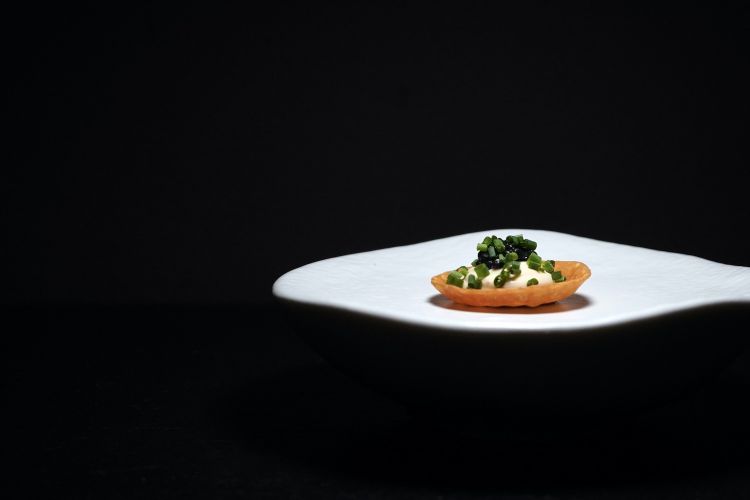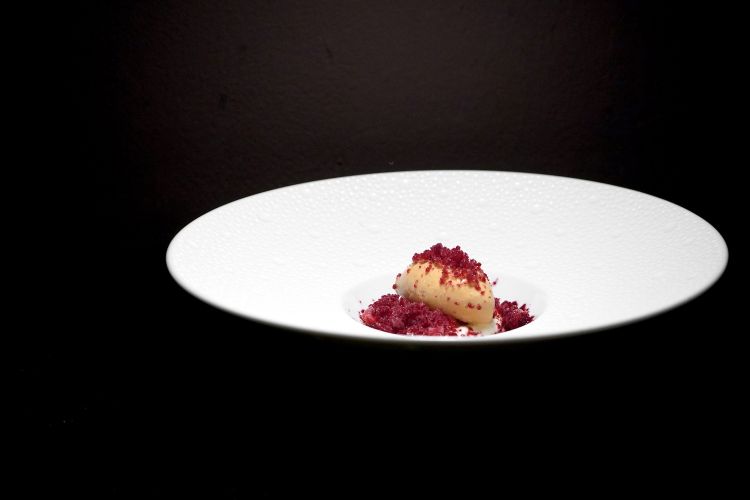After racking our brains to find faults, the only non-positive thing that can be said is: due to the narrow spaces, the location of the restaurant is inadequate for the great quality not only of the cuisine, but also of the service, even though the waiters slalom with agility and a certain elegance between the tables, coordinated by the very good Ambra Sberna, total efficiency and a friendly smile. (Spoiler alert: soon, Materia will change address, moving a few hundred metres, to a much larger building. It will be a whole different story. We await official announcements to this effect).
But for the rest: we already knew that Davide Caranchini is one of the best interpreters of the new Italian cuisine. We also knew that – given his young age when he started out years ago (he was born in 1990) - he could only strengthen his ideas and style. Indeed he got rid of the real or seeming influences that marked him as a 'chef à la mode de' in the early days. And he has consolidated his identity, an authentic one because it is the result of the area where he was born and works, that of Lake Como “of which everyone thinks only in terms of water but in fact you can find mountains here, and countryside too. And that is our greatest luck! Here we have two well-separated macro-seasons: spring-summer is all about lake and countryside vegetables, while autumn-winter is all about forest and mountain vegetation”.

The current dining room of Materia, in Cernobbio (Como). Please note: the restaurant closes from the 16th of January for a couple of weeks. The game menu A walk on the wild side will be available as long as nature allows, probably until mid-February or so
confirmed all the aforementioned positive vibes during a tasting of his new, top-notch menu,
A walk on the wild side, a gastronomic excursion that refers precisely to autumn-winter. In other words, a gluttonous game around game, the forest, the earthy local area. Eleven courses - plus one off the menu, in our case – were interpreted with great attention to sustainability too, as well as with an almost informative approach. As
Caranchini himself explains: “I was born locally [to be precise, in Schignano, a small municipality in the Val d'Intelvi, a mountainous valley area nestled between Lake Como and Switzerland] and I was raised on game. In restaurants, you always think it will be heavy. It’s an exaggeration. In approaching the idea of dedicating one of our menus to game and the forest, we thought of a different way”. The inspiration came from
Walk on the wild side, a song by
Lou Reed: “We started from there. In an interview, the singer explained: the sense of that musical composition was to introduce 'normal' people to aspects of life that would otherwise remain unavailable to them. Similarly, we want to make our diners enjoy game dishes that they would otherwise not eat, and to do this we propose them in a different way, removing the element of fatness, heaviness, and making them very light. We have been working on this for four months”.
Then, there is the other element we mentioned, sustainability: “Eighty per cent of the meat is sourced locally. There is a really well-structured hunting area in my Val d'Intelvi, the Comprensorio Alpino di Caccia Prealpi Comasche. It does a great job. It even has an office equipped with cold rooms: the hundred or so hunter-members, who follow the culling quotas decided by the Lombardy Region, deliver their animals there, which are slaughtered, stored, stamped by the ASL doctor and can then be sold. In a world where there is never enough talk - but to a certain point, far too much talk! - of sustainability, eating meat that has been hunted is in my opinion the only way forward, because here at home we are literally invaded by wild animals, to the point that they are even destroying the ecosystem. Wild boar, deer, roe deer... There are so many of them! Until ten years ago it was unthinkable, but now you always find them along the road,” he says. Hunting in this way makes sense, says Caranchini, precisely because of the environmental balance. And cooking game dishes becomes the closing of a virtuous circle.

The kitchen staff: Simone Arnaboldi, Davide Caranchini, Jordi Prenga and Fuyu Lin
The evolution of the chef is also virtuous. For a long time, he was considered to be the son of the northern European school, of which he has in fact many stigmas. On closer inspection, however, the latter are simply due to the overlapping gastronomic cultures, an inevitable comparison between the mountain cuisine of northern Italy and that which exploded years ago in the Scandinavian countries. These are considerations we have already made many times before, speaking for example of
Alessandro Gilmozzi,
Alessandro Dal Degan, the South Tyrolean trend and
Cook the mountain in particular, alias
Norbert Niederkofler...
Caranchini: “I think we had our own specific identity even before the pandemic broke out. Of course, we were more immature, we were pushing hard to say something to the world, to get noticed. We probably didn't have full confidence in our means. Covid and the lockdowns served us well because we had to stop and we took the opportunity to analyse what we were becoming, what had been done and what had been said about us. Too many times we were associated with Noma, “your cuisine is that kind”. It wasn't true. I felt like they were setting boundaries to my work. Now I feel freer, my style hasn't changed, it keeps its characteristics, the bitter note, the acidity... But I think it has evolved in a more elegant, less brutal way. We even use tablecloths now! We are super happy.”

Dining room staff: Luca Sberna, Ambra Sberna, Daniel Crimella
So here we are, at the end of the meal. The
Tartare of venison, seaweed and bergamot pesto, sea urchins, pine nuts, plankton and mizuna is remarkable, harmonious, austere like the whole meal, which is not trying to please but is direct, pure, essential in its well-defined nuances.
Caranchini makes decisive and precise choices. The
Roe deer with cocoa, a tataki with cocoa bean broth, is exceptional. It recalls the classic-Italian concept of dolceforte; the Colombian cocoa tea, immediately brings bitter notes that embrace the sweetness and irony character of the meat; these latter sensations emerge instead as a really long aftertaste. Perfect concept, explosive palate.
The Grilled Salad and Black Truffle is a small masterpiece with at least four different crunchy textures. Winter storytelling in your mouth. The off-menu dish (Pheasant stuffed with royale and white truffle) is obviously much more rounded, a kind of joyful pause before pushing again with Hare, raspberry, juniper and its garnishes, a very fine recipe. The following Tagliolini with cuttlefish liver, squid ink, hare finanziera and oyster poses a question: why include them in this menu? “Too often the end of a tasting menu has a sort of 'boring drift', everything falls flat, the last courses go almost unnoticed. Instead, we wanted to create a logical thread between the last protein dish, the hare, and the following desserts. I wanted this last tasting to disorientate. To take a break and then start again”.
Ultimately: “This is our path now: maximum subtraction. A more difficult job, but one that gives the greatest satisfaction and a different taste response”.
Below are our tastings one by one, the photos are by Tanio Liotta.

Koji tartlet, yeast, lemon, herring caviar and chives

Carrot waffle, smoked eel butter, red onion gel and chervil leaves

Lake Carbonara: cooked egg cream on the base, then a layer of dehydrated trout, pecorino cheese and pepper

Savoury crème caramel with kombu seaweed, soya and wasabi

Venison tartare, seaweed and bergamot pesto, sea urchin, pine nuts, plankton, mizuna

Venison and cocoa: venison tataki with cocoa bean broth

Pigeon peas, fried chicory, Voatsiperifery pepper and bagna cauda

Grilled salad and black truffle: cream of pumpkin cooked and marinated with ingredients used to make carpione, walnut mayonnaise, pumpkin seeds, fermented celeriac, crispy celeriac, bbq-cooked kale, black truffle and a sauce of mushrooms, lichen, truffle and red fruits

Wild game buttons in forest broth and rosemary: the filling is made from scraps of hare, wild boar and venison. Then hare livers to give creaminess. The forest broth is made from mushrooms, red fruits, bark, mosses and herbs. To finish, rosemary oil

Wild boar, beetroot and roses: wild boar stew with beetroot juice, rose water, marinated beetroot and a veil of beetroot and rose water

Off menu: Pheasant stuffed with royale and white truffle

Hare, raspberry, juniper and side dishes: hare fillet, pickled mustard seeds, lemon thyme, juniper, raspberry. On the side truffle cream with pickled Jerusalem artichoke and horseradish flan, to go with

Tagliolini with cuttlefish liver, cuttlefish ink, hare finanziera and frozen, grated oyster

Birch salad: birch cream, birch syrup, red fruits, herbs, wild leave

Porcini mushrooms, passion fruit and vegetable artichoke 'black pudding': porcini custard, passion fruit reduction, crispy Jerusalem artichoke, frozen-dried white truffle, artichoke 'black pudding' (oxidised artichokes and cocoa)

Mascarpone, yeast and red fruits: lightly sweetened mascarpone cream, yeast garum ice cream, eucalyptus oil, blackberry granita and frozen raspberries
Translated into English by Slawka G. Scarso